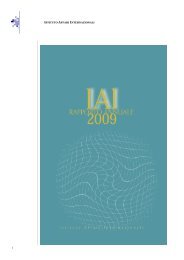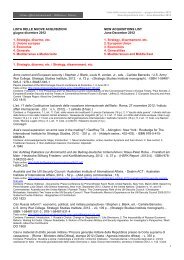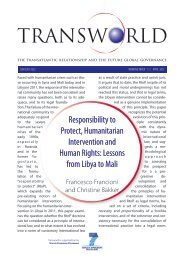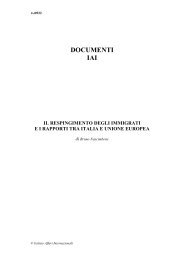Paper - IAI - Istituto Affari Internazionali
Paper - IAI - Istituto Affari Internazionali
Paper - IAI - Istituto Affari Internazionali
Create successful ePaper yourself
Turn your PDF publications into a flip-book with our unique Google optimized e-Paper software.
<strong>IAI</strong>0909<br />
DOCUMENTI<br />
<strong>IAI</strong><br />
THE TREATY ON FRIENDSHIP, PARTNERSHIP AND<br />
COOPERATION BETWEEN ITALY AND LIBYA:<br />
NEW PROSPECTS FOR COOPERATION IN THE<br />
MEDITERRANEAN?<br />
by Natalino Ronzitti<br />
<strong>Paper</strong> presented at the Mediterranean Strategy Group Conference on "Is regional cooperation in the<br />
Maghreb possible? Implications for the Region and External Actors", in cooperation with German<br />
Marshall Fund of the United States<br />
Genoa, 11-12 May 2009<br />
© <strong>Istituto</strong> <strong>Affari</strong> <strong>Internazionali</strong>
<strong>IAI</strong>0909<br />
THE TREATY ON FRIENDSHIP, PARTNERSHIP AND COOPERATION<br />
BETWEEN ITALY AND LIBYA: NEW PROSPECTS FOR COOPERATION<br />
IN THE MEDITERRANEAN?<br />
by Natalino Ronzitti *<br />
On August 30 2008, Italian Prime Minister Silvio Berlusconi flew to Benghazi to sign<br />
the Treaty on Friendship, Partnership and Cooperation between Italy and Libya,<br />
concluding the long negotiating process that began under previous Italian governments<br />
and was accelerated by the current administration. 1 The Treaty was meant to put an end<br />
to the dispute between the two countries and Libya’s claims relating to Italian<br />
colonialism. In greeting Colonel Muammar Gheddafi, Berlusconi expressed his regret<br />
for the colonial period in very strong terms.<br />
In the name of the Italian people, as head of the government, I feel it my duty to<br />
apologize and express my sorrow for what happened many years ago and left a scar on<br />
many of your families. 2<br />
Berlusconi also handed over the statue of the Venus of Cyrene, which was brought to<br />
Italy during the colonial period and which the Italian administrative court ruled had to<br />
be returned to Libya in a controversial judgment of 2007. 3<br />
1. Past record<br />
The provisions of the Benghazi agreement were already contained in nuce in the July 4<br />
1998 Joint Communiqué signed for Italy by then Foreign Minister Lamberto Dini as a<br />
premise for an agreement with broader political scope. However, the ups and downs in<br />
Italian-Libyan relations prevented such an agreement from being concluded, in spite of<br />
the efforts of all governments in the following decade, including those of centre-left.<br />
Relations with Libya have never been easy, because of both the colonial heritage and<br />
the embargo imposed on Libya by western countries. After Gheddafi’s rise to power in<br />
1969, Italians were thrown out of the country and their property confiscated.<br />
Nevertheless, trade relations continued thanks to ENI, the Italian national oil and gas<br />
company, which maintained a constant presence in the country, even during the years of<br />
international terrorism and sanctions on Libya . And, of course, Libyan investments in<br />
Fiat.<br />
* Scientific Advisor, <strong>Istituto</strong> <strong>Affari</strong> <strong>Internazionali</strong>, Rome; Professor of International Law, LUISS<br />
University, Rome. The author is grateful to Ms Silvia Colombo, junior researcher at the <strong>IAI</strong>, for her<br />
research assistance.<br />
1 The text of the Treaty in Italian only is annexed to the law authorizing the ratification and<br />
implementation (Law no. 7 of February 6 2009).<br />
2 (All quotes translated from the Italian) http://www.it/Presidente/Interventi/testo_int.asp?d=40139.<br />
3 N. Ronzitti, “Sugli obblighi di restituzione dell’Italia la sentenza amministrativa non convince”, in<br />
Guida al Diritto. Il Sole 24 ore, no. 21, 2007, pp. 100 ss.<br />
© <strong>Istituto</strong> <strong>Affari</strong> <strong>Internazionali</strong><br />
2
<strong>IAI</strong>0909<br />
Italy-Libya relations reached an all time low in 1986, when Libya launched a missile<br />
which fell into waters close to the island of Lampedusa in reprisal for the US bombing<br />
of Tripoli and Benghazi. The aircraft had not taken off from Italian bases nor flown<br />
over Italian territory, but according to Gheddafi, they had made use of the US<br />
transmission station situated on the island. There had also been clashes with the United<br />
States in preceding years because of the transit and exercises of the US 6th Fleet in the<br />
Gulf of Sidra, which Libya claims is a historic bay and therefore part of its national<br />
waters.<br />
Libya was accused of supporting international terrorism and Libyan agents were<br />
suspected of having provoked the airplane crashes in Lockerbie (1988) and Niger<br />
(1989), involving Pan Am (US) and Uta (France) aircraft, respectively. Internationally<br />
isolated, Libya was forced to hand over the presumed terrorists to a Scottish court<br />
sitting in the Netherlands and to pay considerable damages to the victims’ families.<br />
The Security Council imposed sanctions on Libya in 1992 and only revoked them in<br />
2003, after Libya took on the commitment, in a letter addressed to the Security Council,<br />
not to participate directly or indirectly in perpetrating acts of international terrorism and<br />
declared that it was giving up its programme for the construction of weapons of mass<br />
destruction. The European Union had also put an embargo on Libya in (1986). It is<br />
interesting to note that the Preamble of the 2008 Italy-Libya agreement mentions<br />
“Italy’s important contribution in bringing the embargo to an end” .The United States<br />
only picked up diplomatic relations with Libya in 2005.<br />
Gheddafi’s Africa policy also caused problems, with the intervention in the civil war in<br />
Chad and the clashes with the factions supported by France. Not to speak of Libya’s<br />
claims on the Aouzou strip, which was only returned to Chad in 1994, following a<br />
judgment by the International Court of Justice. 4<br />
2. Opportunities and challenges of the new Italian-Libyan framework of<br />
cooperation<br />
The normalisation of Italian-Libyan relations with the conclusion of the Treaty of<br />
Benghazi was preceded by a number of bilateral agreements, 5 which nevertheless left<br />
many questions unanswered: from Libyan requests for reparations for the damages<br />
caused by colonialism to the credit due Italian firms for work that was carried out but<br />
never paid. Not to mention the delicate matter of illegal immigration, regulated by a<br />
bilateral agreement of December 2000 on the fight against terrorism, organised crime<br />
and illegal immigration, which came into force in December 2002, and the two<br />
Protocols of December 29 2007, which were not implemented. 6 In any case, a<br />
framework agreement was still missing.<br />
4 ICJ, Case concerning the Territorial Dispute (Libyan Arab Jamahiriya/Chad), Judgment of 3 February<br />
1994.<br />
5 See the Appendix.<br />
6 http://www.programmaintegra.it/modules/news/article.php?storyid=3468<br />
© <strong>Istituto</strong> <strong>Affari</strong> <strong>Internazionali</strong><br />
3
<strong>IAI</strong>0909<br />
Like previous treaties, the 2008 Treaty is in Italian and Arabic. Both texts are authentic.<br />
The Treaty is an ambitious document emphasizing the “special and privileged”<br />
relationship that the two countries intend to develop, without forgetting the roles that<br />
they pursue, respectively, in the European Union and the African Union.<br />
The Treaty is made up of three parts: general principles; closing with the past and<br />
ending the disputes; partnership. It begins with a long preamble which sets down,<br />
among other things, the will to close with the “painful ‘chapter of the past’ for which<br />
Italy has already expressed its regret for the suffering that Italian colonization caused<br />
the Libyan people”. In short, Libya has managed to receive a “condemnation” of Italian<br />
colonialism, which is reflected in several of the Treaty’s provisions. The reference to<br />
regional cooperation is also significant. This is attested to by the negotiations for a<br />
framework agreement between the European Union and Libya which started in<br />
November 2008.<br />
A good part of the section dedicated to the principles repeats norms deriving from<br />
international customary law or the UN Charter, to which the Treaty constantly refers:<br />
respect for sovereign equality, prohibition of the threat or use of force, non interference<br />
in internal affairs, respect for human rights and fundamental freedoms.<br />
But some clauses are not that “neutral”. For example, the prohibition to carry out hostile<br />
acts that set out from the respective territories triggered speculation in the media that<br />
this was incompatible with Italy’s membership in NATO. Actually, this is not a “nonaggression”<br />
pact and it is therefore not incompatible with the NATO Treaty, should<br />
Libya act outside of “international legality” as laid down in the provision. Nevertheless,<br />
more complex instances can be envisaged and problems could arise should the US fleet,<br />
after leaving bases in Italy, navigate in the Gulf of Sidra to reassert the freedom of the<br />
high seas. The reference to international law at the beginning of the provision is meant<br />
to protect operations in self-defense or under UN authorization that set out from Italian<br />
territory.<br />
The notion of “international legality”, an unusual expression for diplomatic documents,<br />
is repeated in the last provision of the Treaty and constitutes the framework in which the<br />
relations between the two countries are to unfold. Another interesting provision is the<br />
one on human rights and fundamental freedoms contained in Art. 6, which refers to Art.<br />
14 of the Universal Declaration of Human Rights. The reference to the Declaration and<br />
to the UN Charter is supposed to allow Italy to ask for their respect, even though the<br />
Declaration is not a legally binding instrument.<br />
Also worthy of mention is the third paragraph of Art. 19, which commits the parties to<br />
collaborating to prevent illegal immigration in the countries of origin of the migratory<br />
flows through bilateral and regional initiatives. Among other things, Libya is a party to<br />
all the most important international human rights treaties, with the exception of the<br />
1951 Convention on Refugees, as well as being party to the 1981 African Charter on<br />
Human and People’s Rights, which contains provisions on the treatment of foreigners.<br />
© <strong>Istituto</strong> <strong>Affari</strong> <strong>Internazionali</strong><br />
4
<strong>IAI</strong>0909<br />
The second part of the Treaty is the most onerous: closing with the past. Italy is<br />
committed to building basic infrastructure for a total of $5 billion. The annual<br />
expenditure will amount to $250 million over 20 years, to be drummed up through an<br />
increase in the Ires tax (tax on company income) of companies operating in the field of<br />
hydrocarbon research and development, headquartered in Italy, and with a capitalisation<br />
of over €20 billion, basically ENI. It is hard to predict how much this will amount to, as<br />
it depends on market conditions, without considering the risk of nationalization of<br />
energy sources being rumored in Libya because of the fall in oil prices. 7<br />
The work will be carried out by Italian companies with funds managed directly from<br />
Italy. Consequently, no funds will be transferred to Libya. Since the work will be<br />
carried out in a non-EU country, EC legislation relative to contracts does not hold and<br />
the exclusive restriction favoring Italy companies is fully legitimate. But 20 years are a<br />
long time, and the matter will have to be managed by the joint commission envisaged<br />
by the Treaty for that purpose with wisdom and common sense. Less onerous but still<br />
Italy’s responsibility are the “special initiatives” for “the benefit of the Libyan people”,<br />
such as scholarships, rehabilitation of victims of mine explosions and the return of<br />
archeological artifacts shipped to Italy during the colonial period.<br />
Italy’s commitments are substantial. What are the benefits? There is a commitment to<br />
reach an agreement within a joint committee for payment of the sums still due Italian<br />
companies. The sum, generally quantified as €620 million has not been laid down<br />
anywhere, nor has the time in which it is to be repaid. Since Italian entrepreneurs have<br />
also accumulated fiscal and administrative debts, there is the risk that the compensation<br />
will not be sufficient. Some say that Italy could deduct the sum due Italian<br />
entrepreneurs from the installments to be paid out for building infrastructures in Libya,<br />
should that country not pay up. But this would mean the end of the Treaty. Furthermore,<br />
from a strictly legal point of view, it is difficult to rely on this kind of mechanism, since<br />
the sum claimed by the Italian entrepreneurs has not been set down (at least in the<br />
Treaty) while the one for the infrastructure projects has.<br />
Another thorny question concerns Italian people expelled from Libya. The Treaty does<br />
not provide for compensation to the approximately 20,000 Italians driven out of Libya<br />
in July 1970 after Gheddafi came to power. Italy basically seems to have renounced on<br />
this point. In order to make up this injustice, the law authorising the ratification and<br />
execution of the Treaty, 8 introduces a procedure for compensation: Italy will pay out<br />
€150 million, a sum slightly higher than the one agreed upon in Law 1066/1971, but<br />
which still does not entirely cover the sum claimed by those who were expelled from<br />
Libya. Under the treaty, they are the object only of an ad hoc non-financial provision.<br />
Until now, Libyan legislation prohibited them from entering the country. Now, Art. 11<br />
of the Treaty obliges Libya to grant them visas for tourism, work or other purposes.<br />
This provision also applies to the Italian citizens who voluntarily left the country before<br />
the expulsion was ordained.<br />
7 http://archiviostorico.corriere.it/2009/gennaio/25/Gheddafi_petrolio_non_sale_nazionalizzo_co_9_0901<br />
25075.shtml.<br />
8 http://www.airl.it/Leggeratificatrattato.pdf published in Gazzetta Ufficiale, no. 40 of February 18 2009.<br />
© <strong>Istituto</strong> <strong>Affari</strong> <strong>Internazionali</strong><br />
5
<strong>IAI</strong>0909<br />
3. The partnership and the immigration chapter<br />
The most ambitious part of the Treaty is the one on partnership. Mainly of a<br />
programmatic nature, it does not allocate any funds, except for the fight against illegal<br />
immigration. Cooperation is envisaged in many sectors: culture, science, economy,<br />
industry, energy, defense, non-proliferation and disarmament, the fight against terrorism<br />
and illegal immigration. The Treaty actually foresees the possibility of making the<br />
Mediterranean a weapons of mass destruction free zone in “full respect of the<br />
obligations deriving from international agreements and treaties on the matter”. Yet, it is<br />
doubtful that that provision can be considered a commitment in favor of denuclearised<br />
zones or of turning the Mediterranean into a nuclear weapons free zone. Nevertheless,<br />
this provision may gain new vigor with the “zero option” put forward by US President<br />
Barack Obama during the last NATO summit in Prague.<br />
The provision of most immediate interest is the one that concerns the fight against<br />
illegal immigration, in particular via sea. This phenomenon, according to recent<br />
statistics from the Italian Ministry of the Interior, was on the increase in the first months<br />
of 2009 with respect to the previous year. 9 Art. 19 of the Treaty calls for two things in<br />
this respect. On the one hand, previous agreements and protocols on immigration, in<br />
particular those stipulated in 2007, are to be implemented, and the approximately 2000<br />
km of Libyan coast patrolled by mixed crews on patrol boats provided by Italy. Six<br />
patrol boats are supposed to enter into operation on 15 May 2009. 10 On the other,<br />
Libyan land borders are to be controlled by a satellite detection system jointly financed<br />
by Italy and the European Union. The system is quite expensive – even though the<br />
financial commitment has not yet been determined– but it does not involve the<br />
deployment of Italian police forces.<br />
This is the part of the Treaty that raised the strongest human rights concerns about the<br />
fate of the immigrants turned back and left in the desert. Italy and Libya are both parties<br />
to the 2000 UN Protocol against organized crime to combat the trafficking of human<br />
beings via land, sea and air. 11 However, Libya, as said before, is not party to the 1951<br />
Convention on refugees, even though it has ratified regional and universal instruments<br />
that safeguard human rights.<br />
As seen, the partnership involves complex commitments that will have to be further<br />
defined during implementation. To that end, management bodies had to be set up:<br />
- a Partnership Committee composed of the Prime Minister of Italy and the Secretary of<br />
the General People’s Committee in Libya, which will meet annually, alternately in Italy<br />
and Libya. The Committee adopts the provisions needed to implement the Treaty;<br />
- an Implementation Committee at the Minister of Foreign Affairs level in Italy and the<br />
Secretary of the General People’s Committee for foreign affairs and international<br />
cooperation in Libya, which will also meet annually, alternating between Italy and<br />
9 http://www.repubblica.it/2009/04/sezioni/cronaca/immigrati-6/record-sbarchi/record-sbarchi.html.<br />
10 http://www.interno.it/mininterno/site/it/sezioni/sala_stampa/gallery/2009/0954_2009_04_29_maroni_qu<br />
estion_time/index.html.<br />
11 http://www.admin.ch/ch/i/ff/2005/6077.pdf.<br />
© <strong>Istituto</strong> <strong>Affari</strong> <strong>Internazionali</strong><br />
6
<strong>IAI</strong>0909<br />
Libya. Extraordinary meetings can also be held, upon request of the party with<br />
complaints about breaches of the Treaty. In this case, the Committee functions like a<br />
dispute-settlement mechanism;<br />
- regular consultations between the parties.<br />
The Treaty entered into force on March 2 2009, when ratifications were exchanged<br />
during Prime Minister Berlusconi’s visit to Sirte. 12<br />
4. The Partnership in practice between economic interests and domestic dynamics<br />
How can the Italy-Libya Treaty be assessed? First of all, given the programmatic<br />
nature of many of its provisions, much will depend on how it is implemented. This will<br />
in turn depend on the will of the two parties and developments in the Libyan regime.<br />
The lack of a western type democracy in Libya is well known. As a result, the focus<br />
will be on what kind of domestic fallout this broad process of diplomatic normalization<br />
between Libya and the West will have in terms of the adoption of a modern<br />
Constitution and the implementation of the principle of the separation of powers.<br />
Undoubtedly, the Treaty has substantial “costs” for Italy, but on the whole it represents<br />
a good framework for a real partnership. Libyan investment in Italy is on the rise. The<br />
government in Tripoli has activated its diplomatic channels to organize a meeting to<br />
determine into which sectors and which Italian firms to channel fresh capital from<br />
Libyan sovereign funds. The Libyan Central Bank and the sovereign Libyan Investment<br />
Authority (LIA) have bought 4.9 percent of Unicredit and are about to buy up to 5<br />
percent of ENI. Other investments on the horizon include an important share in<br />
Telecom Italia. 13<br />
The Libyans, however, are not interested only in large works. During a meeting of the<br />
Libyan Minister of Planning and president of LIA, Abdul Hafiz Zlitni, and Prime<br />
Minister Berlusconi and Minister of the Economy Giulio Tremonti, on February 12<br />
2009, the Libyans were interested in learning more about the Italian industrial system,<br />
in particular small and medium-sized businesses, as a way to help Libya develop new<br />
modern industrial districts. This is also part of the strategy Gheddafi intends to follow to<br />
fulfill his commitment to concentrate 90 percent of Libya’s foreign investment in Italy<br />
and to give priority to Italian businesses that want to operate in Libya. 14 Given the<br />
concrete interest manifested by Italian firms, the Special Agency for international<br />
activity of the Milan Chamber of Commerce organised a multi-sectoral mission to<br />
Libya for entrepreneurs on April 1-3 2009.<br />
12 http://www.ilsole24ore.com/art/SoleOnLine4/Mondo/2009/03/Italia-Libia-trattato.shtml.<br />
13 G. Pons, “I fondi libici in Italia con Mediobanca”, La Repubblica, February 13 2009.<br />
14 C. Marroni, “Il Libia una corsia preferenziale”, Il Sole 24 Ore, March 3 2009.<br />
© <strong>Istituto</strong> <strong>Affari</strong> <strong>Internazionali</strong><br />
7
<strong>IAI</strong>0909<br />
Concluding remarks<br />
The Treaty of Friendship, Partnership and Cooperation between Italy and Libya marks<br />
the conclusion of long negotiations on diplomatic normalization between the two<br />
countries coinciding with the end of sanctions on Libya. Closer bilateral ties between<br />
Italy and Libya can boost Libya’s integration into the circuit of international<br />
cooperation at various levels.<br />
The colonial heritage has long conditioned Italo-Libyan relations, curbing their growth<br />
and periodically triggering tensions. Putting an end to the disputes related to Italian<br />
colonialism – with “costs” that are not negligible for Italy – the Treaty has contributed<br />
to creating a favorable climate for a major improvement in bilateral relations. In<br />
addition, the Treaty provides a new frame of reference for cooperation in many sectors.<br />
The economic sector is particularly promising since trade relations have always been<br />
important and Libyan investments in Italy have increased constantly in recent years. No<br />
less important is the part of the Treaty on the fight against illegal immigration, which<br />
calls for Libyan coastline patrol by mixed crews and land border satellite surveillance.<br />
As past experience proves, cooperation in this sector is difficult. According to some<br />
commentators, the approach envisaged in the Treaty would raise serious human rights<br />
concerns, in particular about the fate of immigrants turned back.<br />
In general, the provisions on Partnership of the Treaty are mainly programmatic. Some<br />
of the more complex commitments will have to be defined in more detail and the<br />
transition to their implementation will not be easy. In the past, various bilateral<br />
agreements have remained dead letter. Much will depend on the internal dynamics of<br />
the Libyan regime and the evolution of its regional policies and its relations with other<br />
international actors. Italy will in any case, thanks also to this new Treaty, be able to<br />
make an important contribution to the consolidation that has opened the door to new<br />
relations between Libya and the West.<br />
© <strong>Istituto</strong> <strong>Affari</strong> <strong>Internazionali</strong><br />
8
<strong>IAI</strong>0909<br />
Bibliography<br />
C. Gazzini, “Assessing Italy’s Grande Gesto in Libya”, Middle East Report, 16 March<br />
2009 (http://www.merip.org/mero/mero031609.html).<br />
C. Marroni, “Il Libia una corsia preferenziale”, Il Sole 24 Ore, 3 March 2009.<br />
G. Pelosi, “La diplomazia dell’Eni dietro l’intesa con la Libia”, Il Sole 24 Ore, 4 March<br />
2009.<br />
G. Pelosi, “Tripoli offre capitali e chiede in cambio legittimazione politica”, Il Sole 24<br />
Ore, 13 February 2009.<br />
G. Pons, “I fondi libici in Italia con Mediobanca”, La Repubblica, 13 febbraio 2009.<br />
N. Ronzitti, Il Trattato Italia-Libia di amicizia, partenariato e cooperazione, study<br />
prepared for the Italian Senate (Senato della Repubblica, Servizio Studi, Servizio<br />
<strong>Affari</strong> <strong>Internazionali</strong>, Dossier no. 108, January 2009)<br />
N. Ronzitti, Luci e ombre del Trattato tra Italia e Libia, in <strong>Affari</strong>nternazionali, 8<br />
February 2009 (http://www.affarinternazionali.it/articolo.asp?ID=1066).<br />
A. Varvelli, Il Trattato Italia-Libia e il nuovo contesto economico libico, ISPI Med<br />
Brief no. 8, Milan, <strong>Istituto</strong> per gli Studi di Politica Internazionale, 23 September<br />
2008 (http://www.ispionline.it/it/documents/Med_Brief_8_2008.pdf).<br />
A. Varvelli, L’Italia e l’ascesa di Gheddafi. La cacciata degli italiani, le armi e il<br />
petrolio (1969-1974), Milan: Baldini Castoldi Dalai, 2009.<br />
I. Werenfels, Qadhafi’s Libya. Infinitely Stable and Reform-Resistant?, SWP Research<br />
<strong>Paper</strong> no. 5, Berlin: Stiftung Wissenschaft und Politik, July 2008<br />
(http://www.swp-berlin.org/common/get_document.php?asset_id=5134).<br />
© <strong>Istituto</strong> <strong>Affari</strong> <strong>Internazionali</strong><br />
9
<strong>IAI</strong>0909<br />
Appendix<br />
Bilateral Treaties and other Instruments Between Italy and Libya 15<br />
Exchange of notes for the granting of most favored nation status to Italian ships in<br />
Libyan ports and Libyan ships in Italian ports, Benghazi 1954.<br />
Agreement on economic cooperation and the solution of questions deriving from the<br />
UN resolution of December 15 1950, Rome 1956.<br />
Exchange of notes relative to the Libyan trade office in Milan, Rome 1963.<br />
Agreement on economic, scientific and technical cooperation, Rome 1974.<br />
Agreement to avoid double taxation on income accruing from air navigation, Rome<br />
1976.<br />
Cooperation agreement between the Italian Ministry of Post and Telecommunications<br />
and the Libyan Secretariat for Communications, Tripoli 1978.<br />
Agreement on economic, scientific and technical cooperation, Rome 1979.<br />
Protocol of understanding on trade matters, Rome 1982.<br />
Agreement on cultural and scientific cooperation, Rome 1986.<br />
Procès verbal relative to the question of Arab-Libyan citizens deported to Italy, Tripoli<br />
1988.<br />
Procès verbal relative to the Libyan request to receive documentation concerning the<br />
Libyans deported to Italy from 1923 to 1943, Rome 1988.<br />
Procès verbal relative to the archive research on the fate of the Arab-Libyan citizens<br />
taken prisoner and deported by Italy from 1911 to 1943, Rome 1989.<br />
Joint communiqué, Rome 1998.<br />
Agreement on cooperation in the tourism sector, Rome 1998.<br />
Consular convention, Rome 1998.<br />
Memorandum of understanding on student assistance, Rome 1999.<br />
Memorandum of understanding on medical-health assistance to Libyan citizens needing<br />
treatment, Rome 1999.<br />
Agreement on the fight against terrorism, organized crime, drug trafficking and illegal<br />
immigration, Rome 2000.<br />
Memorandum of understanding on demining, Rome 2000.<br />
Memorandum of understanding on political elections, Rome 2000.<br />
Agreement on the promotion and protection of investments, Rome 2000.<br />
Memorandum of understanding on visas, Rome 2000.<br />
Maritime agreement, Rome 2000.<br />
Agreement on cultural, scientific and technological cooperation, Tripoli 2003.<br />
Protocol on cooperation between Italy and Libya to deal with the phenomenon of illegal<br />
immigration, Rome 2007.<br />
Treaty of Friendship, Partnership and Cooperation between the Republic of Italy and the<br />
Grand Arab Libyan Popular Socialist Jamahiriya, Benghazi 2008.<br />
15<br />
http://www.airl.it/leggietrattati.php; http://documenti.camera.it/Leg14/dossier/Testi/ES0397.htm; A.<br />
Mattiello, M. Magrini (a cura di), Disegno di legge A.S. n. 1333 "Ratifica ed esecuzione del Trattato di<br />
amicizia, partenariato e cooperazione tra la Repubblica italiana e la Grande Giamahiria araba libica<br />
popolare socialista, fatto a Bengasi il 30 agosto 2008", Roma, Servizio Studi del Senato, gennaio 2009<br />
(Dossier n. 92), http://www.senato.it/documenti/repository/dossier/studi/2008/Dossier_092.pdf.<br />
© <strong>Istituto</strong> <strong>Affari</strong> <strong>Internazionali</strong><br />
10
















